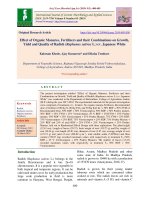Influence of different levels of pruning and growth regulators on growth and yield of guava (Psidium guajava L.) cv. ‘L-49’
Bạn đang xem bản rút gọn của tài liệu. Xem và tải ngay bản đầy đủ của tài liệu tại đây (232.05 KB, 6 trang )
Int.J.Curr.Microbiol.App.Sci (2019) 8(4): 1701-1706
International Journal of Current Microbiology and Applied Sciences
ISSN: 2319-7706 Volume 8 Number 04 (2019)
Journal homepage:
Original Research Article
/>
Influence of Different Levels of Pruning and Growth Regulators on Growth
and Yield of Guava (Psidium guajava L.) cv. ‘L-49’
S.N. Harshitha1*, R.S. Chovatia1 and G.N. Hemavathi2
1
Department, Fruit science, College of agriculture, J.A.U Junagadh, Gujarat, India
2
Department of Fruit science, College of Horticulture, Kolar, Karnataka, India
*Corresponding author
ABSTRACT
Keywords
Pruning, PBZ,
Ethephon, GA3,
Guava
Article Info
Accepted:
12 March 2019
Available Online:
10 April 2019
The present experiment was laid out in Randomized Block Design with factorial concept
(FRBD) consisting of thirteen treatments and three replications involving two factors,
among them first factor contains two levels of pruning (75 cm and 100 cm) and second
factor contains two levels of each growth regulators i.e. PBZ (500 and 1000 ppm),
Ethephon (500 and 1000 ppm) and GA3 (50 and 100 ppm) as well as absolute control. The
results obtained from present investigation revealed that interaction effect of pruning and
chemical spraying on number of fruits per shoot number of fruits per shoot (3.39), fruits
per plant (343.97), maximum yield of fruits per plant (49.14 kg) were found significant in
pruning at 75 cm and PBZ at 500 ppm (P2S1). Whereas, the maximum fruit weight (127.67
g) was recorded in pruning at 75 cm and GA3 at 50 ppm (P1S5).
Introduction
Guava (Psidium guajava L.) belongs to
family Myrtaceae, the apple of tropics and it
is one of highest fruit in area and production
after mango, banana, grapes and citrus. Guava
is very important tropical as well as
subtropical fruit crop of the world and is a
potential crop of India. Due to its hardy,
prolific bearing and highly remunerative
nature, it surpasses many other fruit crops.
More over this fruit can be grown
satisfactorily even in adverse soil and climatic
conditions.
Guava has gained considerable prominence
on account of its high nutritive and medicinal
values and also aroma and flavour. It is a rich
source of vitamin C, pectin, moderately good
source of iron, calcium and a fair source of
phosphorus, besides very rich sources of
dietary fiber. The presence of vitamin C and
other phytonutrients such as carotenoids, isoflavonoids and polyphenols in guava has led
to it being an effective antioxidant. Apart
from being relished as fresh fruit, guava is
also extensively being used for making jelly
and to a limited extent for juice, fruit jam and
canning in sugar syrup or made into fruit
butter. It freezes exceptionally well and the
products are practically indistinguishable
from fresh fruits (Gopikrishna, 1979). As
guava plants exhibits extensive vegetative
growth annually and are highly responsive to
1701
Int.J.Curr.Microbiol.App.Sci (2019) 8(4): 1701-1706
canopy modification, there is always a scope
to increase production and income from a unit
land area by using various cultural techniques
and application of certain chemicals which
restricts the vegetative growth without
affecting the fruit quality. Therefore, the
present investigations are aimed to study the
effect of pruning and growth regulators on
growth, yield and quality of guava fruits.
Materials and Methods
The present investigation was carried out on
“Effect of pruning and growth regulators on
growth, yield and quality of guava
(Psidiumguajava L.) cv. L-49” at Fruit
Research Station, Sakkarbaug, Department of
Horticulture, College of Agriculture, J.A.U.,
Junagadh during summer and kharif
2017,situated at 21.5 N latitude and 70.5 E
longitude with an altitude of 60 meters above
the mean sea level and 80 kilometers away
from the Arabian Sea coast on western side at
the foothill of mountain Girnar sierra.
Thirteen treatments involving two factors
among these first factor contains two levels of
pruning (75 cm and 100 cm) and second
factor contains two levels of each PBZ (500
ppm and 1000 ppm), Ethephon (500 ppm and
1000 ppm) and GA3 (50 ppm and 100 ppm) as
well as absolute control. These are embedded
in Randomized Block Design (Factorial
concept) with three replications and 6m X 6m
spacing of 15 years old plants.
Observation recorded are Plant height (m),
Plant spread (m), No. of shoots/tree, Length
of shoot (cm), No. of flower/shoot, No. of
fruits/shoot, Fruit set (%), Fruit drop (%),
Fruit weight (g), Fruit Length (cm), Fruit
Circumference (cm), Seed weight, Seed: pulp
ratio, Number of fruit/plant, Yield of fruit
(kg/plant) and Yield of fruit (t/ha). The height
of the plant was measured from the ground
level to the tip of the main shoot, The
horizontal distance of plant spread is taken
from one end of the canopy to the other end
was recorded in two directions viz. North –
South and East – West with the help of meter
tape and it was expressed in meter. Number of
shoots/tree was counted from selected five
branches. The average shoot per tree was
calculated from data recorded. Length of
shoot (cm) was recorded from five branches
which were selected and labelled on each tree
and five shoots were tagged. Observations on
shoot length were recorded in centimetres at
an interval of 30 days. Number of
flower/shoot was recorded from tagged shoot
and also those emerged newly on labelled
branches were recorded. The average number
of flower bud per shoot was calculated from
the data recorded. Number of fruits/shoot was
taken from tagged shoot and also those
emerged newly on labelled branches where
fruit are available were recorded. The average
number of fruits per shoot was calculated
from the data recorded. The fruits which have
dropped prior to reach the maturity were
counted and average to obtain effective fruit
drop and depicted as percentage fruit drop.
Five fruit were weighted and averaged to get
the effective weight per fruit in gram.
The length of five fruits was measured
vertically and averaged by Vernier calliper to
obtain the length of fruit (cm). The width of
five fruits was measured horizontally and
averaged to obtain the circumference of fruit
(cm). Seed weight was recorded after the
separation of seeds from the individual ripe
fruit. Seed: pulp ratio was taken account after
the separations of seeds and pulp from the
individual ripe fruit, weight of the seed and
weight of the pulp were recorded. The
number of fruit was counted from each treated
tree. The average number of fruit per tree was
calculated from data recorded. The final yield
per tree in kg was obtained by sum up the
yield of all the pickings.
1702
Int.J.Curr.Microbiol.App.Sci (2019) 8(4): 1701-1706
Similar results were also reported by Jadhav
et al., (2002) in guava.
Results and Discussion
Plant height
Number of fruits per shoot
Minimum plant height (2.82 m) was noted in
pruning at 100 cm (P2) followed by P1.In
foliar spray of growth regulators minimum
plant height (2.72 m) was obtained in PBZ at
500 ppm (S1).The interaction effect of
pruning and chemical spraying was found to
be non-significant with respect to plant height
(Table 1). Reduction in the tree height is due
to the slow response for supply of food
material absorbed by roots and transmission
of the same to main trunk of such tree. These
results were in conformity with the findings
of Kumarand Rattanapal (2010) in guava.
Plant spread E-W and N-S (m)
The minimum plant spread was recorded in
pruning at 100 cm (P2) for both E-W (4.98 m)
and N-S (4.29 m) direction. The minimum
plant spread (4.63 m) was obtained in PBZ at
500 ppm (S1).The interaction effect of
pruning and chemical spraying was found to
be non-significant with respect to plant spread
(Table 1). It is well established fact that
severely pruned trees reduces the canopy
spread compared to unpruned trees. These
results were in conformity with the findings
of Kumarand Rattanapal (2010) in guava.
Number of flowers per shoot
The maximum number of flowers per shoot
(3.96) was recorded in pruning at 75 cm
(P1).The maximum number of flowers per
shoot (4.26) was recorded in PBZ at 500 ppm
(S1).The interaction effect of pruning and
chemical spraying was found to be nonsignificant with respect to the number of
flowers per shoot. Severely pruned trees of
guava induce early emergence of bud sprouts,
increases length of the shoot as well as the
number of flowers per shoot (Table 1).
The effect of pruning with respect to number
of fruits per shoot noted significant result
(Table 2). Maximum fruits per shoot (2.96)
were observed in pruning at 75 cm (P1) and it
was found at par with P2. Foliar application of
PBZ, Ethephon and GA3 significantly
influence the number of fruits per shoot.
The maximum number of fruits per shoot
(3.19) was recorded in PBZ at 500 ppm (S1) it
was found at par with S4. Whereas, the
minimum fruits per shoot (2.56) was recorded
in GA3 at 100 ppm (S6).Increase in the
number of fruits in pruned trees of guava
might be due to the optimum balance between
the vegetative and reproductive growth of the
shoots. But when there is increase in the
pruning intensity, then the number of fruits
per shoot may be decreased.
This is due to loss of bearing area. Similar
results were noted by Braret al., (2007) in
guava. The interaction effect of pruning and
chemical spraying with respect to number of
fruits per shoot was found significant. The
maximum number of fruits per shoot (3.39)
was recorded in treatment together with
pruning at 75 cm and PBZ at 500 ppm (P1S1)
and it was found at par with P1S4. While,
minimum number of fruits per shoot (2.14)
noted in absolute control.
Fruit set (%)
The data regarding effect of pruning with
respect to fruit set was noted significant
result. Effect of PBZ, Ethephon and GA3 with
respect to fruit set was found non-significant.
The interaction effect of pruning and
chemical spraying with respect to fruit set was
found non-significant (Table 1).
1703
Int.J.Curr.Microbiol.App.Sci (2019) 8(4): 1701-1706
Fruit weight
The effect of pruning with respect to fruit
weight was noted significant result.
Maximum fruit weight (112.44 g) was noted
in pruning at 75 cm (P1) followed by P1.Foliar
application of PBZ, Ethephon and GA3
significantly influence the fruit weight. The
maximum fruit weight (121.50 g) was noted
in GA3 at 50 ppm (S5). Whereas, minimum
fruit weight (97.85 g) was noted in Ethephon
at 1000 ppm (S4) in (Table 2). It may be due
to the increased light exposure and
strengthened fruit sink activity by the pruning.
Higher the pruning intensity lower will be the
fruit weight. These findings are also
agreement with Brar et al., (2007) in guava.
The interaction effect of pruning and
chemical spraying with respect to fruit weight
shows significant variation. The maximum
fruit weight (127.67 g) was recorded in
treatment together with pruning at 75 cm and
GA3 at 50 ppm (P1S5) and it was found at par
with P1S2. While, minimum fruit weight
(85.33 g) noted in absolute control.
Table.1 Effect of pruning and growth regulators on plant height, plant spread, number of flowers
per shoot, fruit set (%) of guava
Sr.
No
Treatments
Factor A – Pruning
Pruning (75 cm)
Pruning (100 cm)
P1
P2
S.Em.±
C.D. at 5%
Factor B – Chemical spraying
Paclobutrazol – 500 ppm
S
1
Plant
height
(m)
Plant spread (m)
E-W
N-S
Number of
flowers per
shoot
Fruit
(%)
2.98
2.82
0.04
0.12
5.20
4.98
0.07
0.21
4.29
4.11
0.06
0.18
3.96
3.69
0.08
0.22
75.41
76.97
1.7
NS
2.72
4.63
4.05
4.26
75.16
S2
Paclobutrazol – 1000 ppm
2.86
5.19
4.13
3.82
76.12
S3
Ethephon – 500 ppm
2.94
5.09
4.33
3.77
78.57
S4
Ethephon – 1000 ppm
2.81
4.92
4.06
4.17
71.45
S5
GA3 – 50 ppm
3.00
5.33
4.35
3.50
80.00
S6
GA3– 100 ppm
3.03
5.38
4.29
3.40
75.80
0.07
0.21
6.19
0.13
0.37
6.06
0.23
NS
6.09
0.13
0.38
8.49
2.95
NS
9.58
NS
3.12
*
NS
5.48
*
NS
4.63
NS
NS
3.19
**
NS
67.02
*
S.Em.±
C.D. at 5%
C.V. %
Interaction
PXS
Absolute control
Control v/s Rest
1704
set
Int.J.Curr.Microbiol.App.Sci (2019) 8(4): 1701-1706
Table.2 Interaction effect of pruning and growth regulators on fruit weight, number of fruits,
yield of fruits per plant and yield per hectare of guava
Tr.
No.
Px S
P1S1
P1S2
P1S3
P1S4
P1S5
P1S6
P2S1
P2S2
P2S3
P2S4
P2S5
P2S6
Treatments
Pruning (75 cm) + PBZ (500
ppm)
Pruning (75 cm) + PBZ (1000
ppm)
Pruning (75 cm) + Ethephon (500
ppm)
Pruning (75 cm) + Ethephon
(1000 ppm)
Pruning (75 cm) + GA3 (50
ppm)
Pruning (75 cm) + GA3 (100
ppm)
Pruning (100 cm) + PBZ
(500
ppm)
Pruning (100 cm) + PBZ (1000
ppm)
Pruning (100 cm) + Ethephon
(500 ppm)
Pruning (100 cm) + Ethephon
(1000 ppm)
Pruning (100 cm) + GA3 (50
ppm)
Pruning (100 cm) + GA3 (100
Fruit
weight
(g)
102.17
Number of Number of Yield
of Yield of
fruits per fruits per fruits per fruits
shoot
plant
plant(kg)
(t/ha)
3.39
343.97
49.14
13.63
120.16
2.99
303.92
43.42
12.05
114.67
2.89
293.83
41.98
11.65
98.28
3.18
323.52
46.22
12.82
127.67
2.85
289.80
41.40
11.49
111.67
2.50
254.23
36.32
10.08
99.88
3.00
305.43
43.63
12.11
103.08
2.82
287.30
41.04
11.39
108.67
2.97
302.25
43.18
11.98
97.42
2.78
282.50
40.36
11.20
115.33
2.75
279.83
39.98
11.09
106.85
2.63
268.17
38.31
10.63
85.33
2.7
7.87
4.36
2.14
0.10
0.29
6.08
217
10.00
29.18
6.00
26.00
1.43
4.18
6.07
7.00
0.39
1.41
6.00
ppm)
Absolute control
----S.Em.±
C.D. at 5%
C.V. %
Number of fruits per plant
The effect of pruning with respect to number
of fruits per plant noted significant result. The
highest number of fruits per plant (301.54)
was observed in pruning at 75 cm (P1)
followed by P2. Foliar application of PBZ,
Ethephon and GA3 significantly influence the
number of fruits per plant. The higher number
of fruits per plant (324.7) was recorded in
PBZ at 500 ppm (S1), followed by S4 (Table
2). Whereas, the lower number of fruits per
plant (261.20) was observed in GA3 at 100
ppm (S6). The interaction effect of pruning
and chemical spraying with respect to number
of fruits per plant was found significant. The
higher number of fruits per plant (343.97) was
recorded in treatment together with pruning at
75 cm and PBZ-500 ppm (P1S1) and it was
found at par with P1S4 significantly. While,
1705
Int.J.Curr.Microbiol.App.Sci (2019) 8(4): 1701-1706
lower number of fruits per plant (217) noted
in absolute control.
Yield of fruits per plant
The effect of pruning with respect to yield of
fruits per plant noted significant result.
Maximum yield of fruits per plant (43.08 kg)
were observed in pruning at 75 cm (P1)
followed by P2. Foliar application of PBZ,
Ethephon and GA3 significantly influence the
yield of fruits per plant. The maximum yield
of fruits per plant (46.38 kg) was recorded in
PBZ at 500 ppm (S1), followed by S4 (Table
2). While, the minimum yield of fruits per
plant (37.31 kg) was observed in GA3 at 100
ppm (S6). The interaction effect of pruning
and chemical spraying with respect to yield of
fruits per plant was found significant. The
maximum yield of fruits per plant (49.14 kg)
was recorded in treatment together with
pruning at 75 cm and PBZ at 500 ppm (P1S1)
and it was found at par with P1S4. While, the
minimum yield of fruits per plant (26.00 kg)
noted in absolute control. This is due
metabolic activities have helped to increase
the fruit size and fruit weight and thereby
increase the fruit yield. Higher the pruning
intensity lower will be the yield. The result
was supported by Suleman et al., (2006) in
guava.
References
paclobutrazol and ethephon in
reproductive growth of „Allahabad
Safeda‟ guava (Psidium guajava L.)
plants at different spacing. J. Hortl.
Sci., 5(2): 128-133.
Brar, J. S., Dhaliwal, H. S.; Bal, J. S.;
Dhillon, W. S. and Som Pal Singh
2012. Effect of spacing on canopy
microclimate, vegetative growth and
yield attributes in guava (Psidium
guajava L.). J. Hortl. Sci. Vol., 7(1):
41-45.
Brar, J. S., Thakur, A. and Arora, N. K. 2007.
Effect of pruning intensity on fruit
yield and quality of guava (Psidium
guajava L.) cv. Sardar. Haryana J.
Hort. Sci., 36(1/2): 65-66.
Jadhav, B. J., Mahurkar, V. K. and Kale, V. S.
2002. Effect of time and severity of
pruning on growth and yield of guava
(Psidium guajava L.) cv. Sardar.
Orissa J. Hort., 30(2): 83-86.
Gopikrishna, N.S., 1979. Studies on the
effects of pruning on vegetative
growth, flowering and fruiting in
Sardar guava (Psidium guajava L.).
M. Sc. (Agri.) Thesis, Univ. of Agric.
Sci. Bangalore, India.
Suleman, Mohammed, Sharma, J. R, Ranjeet
Kumar, Gupta, R. B. and Sultan Singh
2006. Effect of pruning on growth and
cropping pattern in guava cv.
Lucknow-49. Haryana J. Hortl. Sci.,
35(3/4): 211-212.
Brar, J.S., and Bal, J. S. 2010. Role of
How to cite this article:
Harshitha, S.N., R.S. Chovatia and Hemavathi, G.N. 2019. Influence of Different Levels of
Pruning and Growth Regulators on Growth and Yield of Guava (Psidium guajava L.) cv. „L49‟. Int.J.Curr.Microbiol.App.Sci. 8(04): 1701-1706.
doi: />
1706
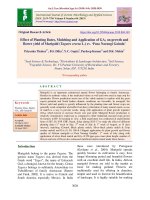
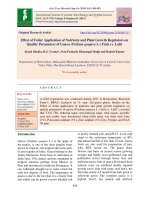

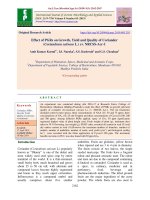
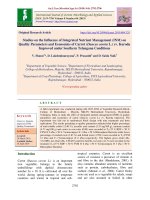
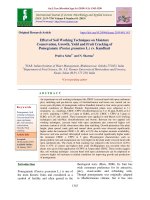

![Effect of post harvest treatments on the shelf life and quality of guava [Psidium guajava (L.)] cv. Allahabad Safeda](https://media.store123doc.com/images/document/2020_01/14/medium_wgi1578938512.jpg)

